Connecting a hydraulic accumulator to the water supply system: options and typical schemes
An autonomous water supply system is a complex technical structure requiring the use of an impressive number of technical equipment. To automate the operation of pumping equipment and the supply of water to taps, you will need to install a hydraulic tank. Agree, not every homeowner knows how to install it, and indeed, what kind of device it is.
We will describe in detail how the accumulator is connected to the water supply system. We will analyze in detail what is necessary for its installation, in which independent water supply networks it is used, with what equipment and how it can be operated.
The installation of a hydraulic tank in accordance with our recommendations will prevent many potential problems: it will protect household appliances and minimize the effects of water hammer. To optimize perception, the presented information is supplemented by photos, diagrams and videos.
The content of the article:
- The device and purpose of the hydraulic tank
- The principle of operation of the accumulator
- Role in the water supply network
- Options membrane closed containers
- Accumulator connection diagrams
- Skilful diaphragm tank selection
- Connecting the accumulator to the water supply circuit
- Proper setup of a new device
- Optimum air pressure
- Conclusions and useful video on the topic
The device and purpose of the hydraulic tank
Accumulator, which is also called a hydraulic tank or a membrane tank, is a sealed metal container in which a pear-shaped elastic membrane partially filled with water is placed. In fact, a membrane placed in the tank body and attached to its body with a flange with a nozzle divides its capacity into two parts: water and air.
With an increase in the volume of water in the hydraulic tank, the volume of air naturally decreases. As a result, the pressure in the water supply system rises. Upon reaching user-specified pressure parameters, it fixed relay, which systematically gives a command to turn off the pump.
The tank body is made of metal, but water does not contact it: it is enclosed inside a chamber-membrane, which is made from durable rubber butyl.
This material resistant to bacteria helps the water not to lose the qualities that are shown to it by sanitary and hygienic standards. When interacting with rubber, drinking water retains all its remarkable properties.
Water in membrane tank enters through a connecting pipe equipped with a threaded connection. The pressure port and outlet of the connecting water supply should ideally have the same diameters. This condition allows you to avoid additional hydraulic losses inside the pipeline system.

To regulate the pressure inside the device, a special pneumatic valve is provided in the air chamber. Air is pumped into the designated compartment through a regular automobile nipple. By the way, through it you can not only pump air, but, if necessary, and bleed its excess.
They pump air into the membrane tank using a compact automobile or simple bicycle pump for this purpose. When water enters the rubber bulb, the compressed air exerts its pressure resistance, preventing the membrane from breaking through. The pressure inside the accumulator is also regulated by compressed air.
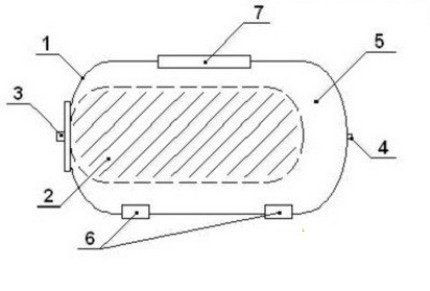
The principle of operation of the accumulator
If the system has just been mounted, most of the internal volume of the accumulator is occupied by the chamber that is designed for air.
Entering the pear-shaped membrane through the pipe, water compresses the air. This happens until the intended pressure is reached. Then the relay switches off the pump. The operation of the relay can be adjusted.
When we open the valve and use water for our needs, the system is depressurized. By pressing on the membrane, air helps the water to exit the tank. This process will occur until the pressure in the system drops to the set minimum of -1.5 atm. At this moment, the pump should start working, forcing water into the tank.
As you know, there is also dissolved air in water. When it accumulates inside the membrane bag, the performance of the accumulator worsens, so it must be pitted. Some models have a special valve for this purpose. If there is no valve, it is necessary to arrange prophylaxis to the membrane tank once every 1-3 months.
It is important to mount correctly accumulator in the water supply system. Then, when it breaks down or when carrying out maintenance work on it, the device can be easily disassembled so that it does not have to completely drain the water from the entire system.
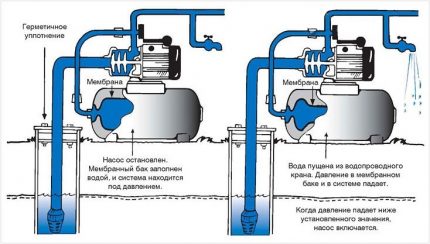
Role in the water supply network
It would seem that the device simply passes water through itself. Could do without it? In fact, it is with the help of a hydraulic tank that a stable pressure is maintained in the water supply system.
If available, the water pump does not turn on so often, which makes it possible to economically use its operational resource. In addition, the system for extracting and transporting water is reliably protected from water shocks.
If, for any reason, the voltage in the mains disappears, a small "emergency" supply of water in the tank will help to solve priority business problems.
We clarify the list of advantages that this rather simple device provides:
- Premature wear of the pump. There is some water in the membrane tank. It meets the immediate needs of the owners of the cottage. And only when the supply runs out, the pump will turn on. It should be noted that all pumps have an operating rate of one hour. In the presence of a hydraulic accumulator, this indicator will not be exceeded, and the unit will last longer.
- Pressure stabilization in the system. If you turn on two taps at the same time, for example, in the bathroom and in the kitchen, pressure differences can affect the temperature of the water. This is very unpleasant, especially for those households who are taking a shower at this moment. Thanks to the accumulator, such misunderstandings can be avoided.
- Water hammer. These phenomena, which can damage the pipeline, can occur when the pump is turned on. With a hydraulic tank, the risk of water hammer is virtually eliminated.
- Water supply. In a country house, the problem of water supply is especially acute. If a sudden power outage occurs and the pump cannot perform its functions, then to solve urgent problems you no longer need to store a supply of water in a bucket or other tank. In the capacity of the accumulator, it is available and is regularly updated.
Obviously, the presence of this device in a water supply system independent of centralized networks is not accidental. It is necessary and useful.
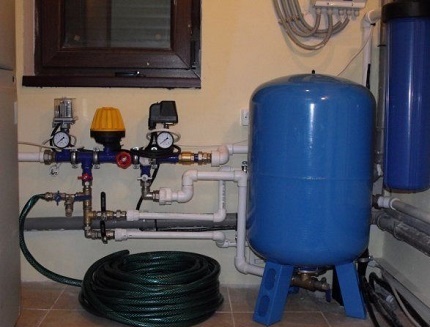
Options membrane closed containers
Membrane tanks are operated as part of pipelines mounted for various purposes, including:
- Cold water supply. The tank is used for the accumulation and supply of cold water, protects a variety of household appliances from water hammer when the pressure in the system changes. Extends the life of the pumps by reducing the number of starts.
- Providing hot water. The device used for this should work successfully in high temperature mode.
- Heating systems. Such tanks are called expansion tanks. They function as part of closed heating systems and are their important components.
Depending on the configuration, hydraulic tanks are horizontal and vertical. However, the principle of their operation does not depend on the configuration.

A feature is the presence of a special valve for bleeding air in the upper part of the vertical models, the volume of which exceeds 50 liters. This air, as mentioned above, accumulates in the upper part of the chamber as the device operates. Therefore, the presence of a bleed valve in this place is a reasonable measure.
If it is necessary to bleed the air mass during the operation of horizontal models, then for this purpose a drain or a separate valve located behind the membrane tank is used. To remove air from small devices, you will have to completely drain the water from it.
Since vertical and horizontal models are equally effective and functional, choosing the right device should be based on the dimensions of the room in which it will be located. Which model fits better into the room, they take it.
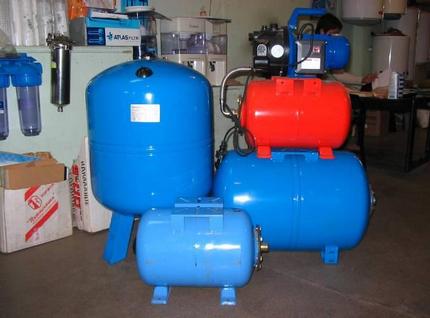
Accumulator connection diagrams
This device can be connected to the water supply system in various ways. The choice of the accumulator connection scheme depends on the quality in which it will be used and what functions it is supposed to be assigned to. Consider the connection schemes that are most popular.
Standard version with surface pump
The most common option for autonomous water supply with a hydraulic accumulator is a tandem with a surface pump. In this case, the hydraulic tank may be part of integrated pumping equipmentassembled by the manufacturer in the factory, or a separate component located next to the pump in a box or in a heated utility room.
A check valve is placed in front of the accumulator in order to prevent a change in the direction of flow, after which a pressure switch is installed, which reacts to a change in pressure, and a pressure gauge for monitoring operating parameters.
For a normal connection to the water circuit, the hydraulic tanks are usually equipped with an angled pipe that connects to the flange:
Use with booster pump station
The booster pump unit is used to constantly maintain and control the pressure in pipelines with active water consumption. Typically, such stations have a pump that operates continuously.
If there is a need to connect additional pumps, the accumulator helps to compensate for the pressure surges that occur in the system.

The same scheme is used if the supply of electricity to booster pumps in the system is unstable, and the water supply should nevertheless be uninterrupted. During a power outage, the supply of water that is contained inside the accumulator is used. In fact, the membrane tank plays the role of a reserve source of water supply during this period.
The more powerful the pumping station, the larger the tasks that are assigned to it. She must support greater pressure, the volume of its hydraulic accumulator should also be large.
Application in submersible pump circuits
To maximize the service life of the submersible pump unit, the number of starts within an hour should correspond to the declared technical characteristics of the device. Usually this indicator is about 5-20 times.
If the pressure in the water supply network drops, when it reaches the minimum value, a relay is activated, which includes a pump that supplies water. At maximum pressure values, the relay switches off, the water supply stops.
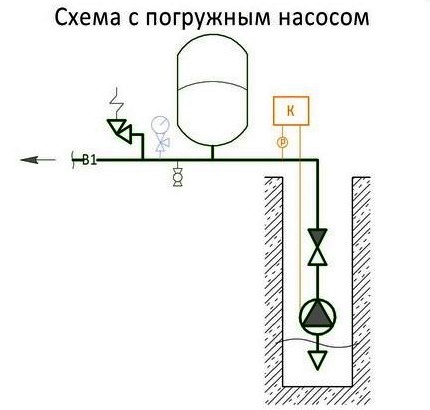
If the water supply system is autonomous and small, even a small amount of water consumption can start the pump. In this case, the operation of the pump will be ineffective. And the device itself will not last as long as its owner would like.
The supply of water contained in the membrane tank will save the situation. In addition, he will not allow a pressure surge at the moment when the submersible pump begins to work.
To choose a suitable hydraulic tank, you need to know the following characteristics: power and frequency of the pump, the estimated water flow per hour and the installation height of the device.
If the connection diagram appears storage water heater, then the accumulator performs the functions of an expansion tank in it. If the water is heated, then its volume will increase. It will expand. For a confined space, which is the water supply system, such a process could lead to devastating consequences if not for the hydraulic tank.

To be included in this scheme, it is necessary to choose a hydraulic accumulator, taking into account its following characteristics: maximum temperature of heated water and maximum allowable pressure in the water supply system.
Skilful diaphragm tank selection
A hydraulic tank is a tank whose main working body is a membrane. Its quality depends on how long the device will last from the moment of connection to the first repair.
The best are products from food (isobutylated) rubber. The metal of the body of the product is important only for expansion tanks. Where water is contained in the pear, the characteristics of the metal are not critical.
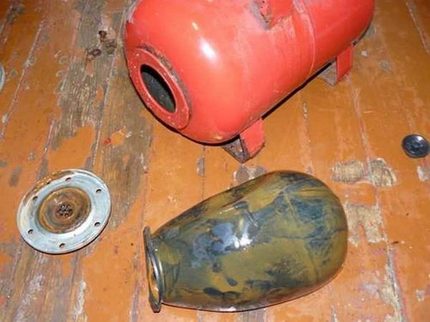
Particular attention when choosing a device should focus on the flange, which, as a rule, is made of galvanized metal. The thickness of this metal is very important.With a thickness of only 1 mm, the product’s life will be no more than 1.5 years, since a gap will certainly form in the metal of the flange, which will damage the entire device.
At the same time, the guarantee for the tank is only a year with a stated service life of 10-15 years. So the hole will appear just after the expiration of the warranty period. And it will be impossible to solder or brew thin metal. You can, of course, try to find a new flange, but most likely you will need a new tank.
To avoid such misfortunes, you should look for a tank whose flange is made of stainless steel or of thick galvanized steel.
Connecting the accumulator to the water supply circuit
As it became clear from everything written above, a membrane tank is not just a container with water. This is a special device involved in a continuous workflow. Therefore, the procedure for installing it is not at all as simple as it might seem. It should be fixed very carefully, taking into account vibration and noise factors.

It is fixed to the floor using rubber gaskets, and to the pipeline - with the help of rubber adapters. And it should also be noted that the diameter of the liner cannot decrease at the output of the hydraulic system.
The new tank should be handled with particular care, filling it with water under low pressure. The membrane from long storage could be caked. A sharp stream of water can damage it and even completely disable it. It is more correct to remove all air from the membrane pear before you start filling it with water. The place to install the accumulator must be selected taking into account its availability.
The process of connecting the accumulator is carried out in the standard sequence:
Proper setup of a new device
The new hydraulic tank should be checked for what is the level of its internal pressure. It is assumed that it should be 1.5 atm. But in the process of transporting the product from the place of production to the warehouse and during storage, a leak could occur, which reduced this important indicator at the time of sale. You can check the pressure by removing the cap on the spool and taking measurements.
Different types of pressure gauges can be used to measure pressure:
- Electronic. These are expensive appliances. The result of their work may be affected by temperature and battery power.
- Mechanical. Available in a metal casing, otherwise called automobile. If this device has successfully passed the test, it is better not to find it. To get the most accurate value, since you will need to measure only 1-2 atm., It is better to buy a device with a large number of divisions on the measuring scale.
Inexpensive pumping stations and automatic pumps are most often equipped with manometers in a plastic case. The error in the readings of such Chinese models is too great.
If there is less air in the tank than necessary, water will take its place. This will affect the pressure of the water in the water supply. At high pressure and pressure will always be high. Higher pressure will provide less water in the membrane pear, so the pump will have to turn on more often. If there is no light, the supply of water may not be enough for all needs.
Therefore, sometimes it would be wiser to sacrifice pressure to achieve other important goals. However, it is better not to lower the pressure below the recommended values, as well as not to exceed the limiting characteristics. Lack of pressure can cause the surface of the bulb to come into contact with the tank body, which is undesirable.
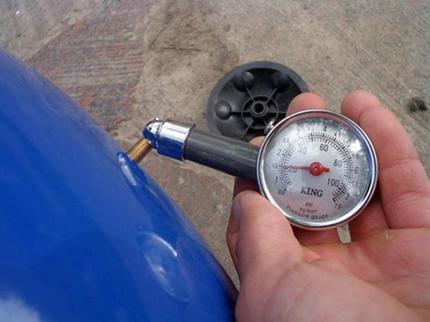
Optimum air pressure
For household appliances to work normally, the pressure in the hydraulic tank must be in the range 1.4-2.8 atm. For better membrane safety, it is necessary that the pressure in the water supply system is 0.1-0.2 atm. exceeded the pressure in the tank. For example, if the pressure inside the membrane tank is 1.5 atm, then in the system it should be 1.6 atm.
This value should be set on water pressure switch, which works in conjunction with a hydraulic accumulator. For a one-story country house, this setting is considered optimal. If we are talking about a two-story cottage, the pressure will have to be increased. To calculate its optimal value, the following formula is used:
Vatm. = (Hmax + 6) / 10
In this formula, V atm. Is the optimal pressure, and Hmax is the height of the highest located water intake point. As a rule, we are talking about the soul. To get the desired value, you should calculate the height of the shower head relative to the accumulator. The data obtained are entered into the formula. As a result of the calculation, the optimum pressure value that should be in the tank will be obtained.
Please note that the obtained value should not exceed the maximum permissible characteristics for other household and plumbing fixtures, otherwise they will simply fail.
If speak about independent home water system simplified, its components are:
- pump,
- accumulator
- pressure switch,
- check valve
- pressure gauge.
The last element is used so that you can quickly control the pressure. His constant presence in the water supply system is not necessary. It can be connected only at the moment when test measurements are made.
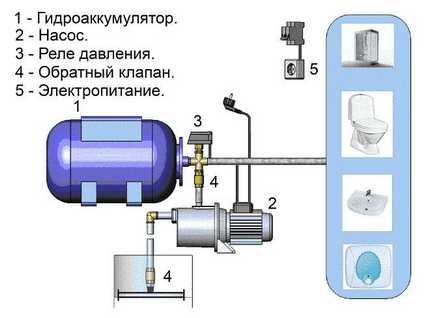
With the participation of a surface pump in the circuit, a hydraulic tank is mounted next to it. The check valve is then installed on the suction pipe, and the remaining elements form a single bundle, connecting with each other using a five-pin fitting.
The five-pin device is ideally suited for this purpose, since it has terminals of various diameters. Incoming and outgoing pipelines and some other bundle elements can be connected to the fitting with the help of American women to facilitate preventive and repair work in individual sections of the water supply.
However, this fitting can be replaced with a bunch of connecting elements. But why?
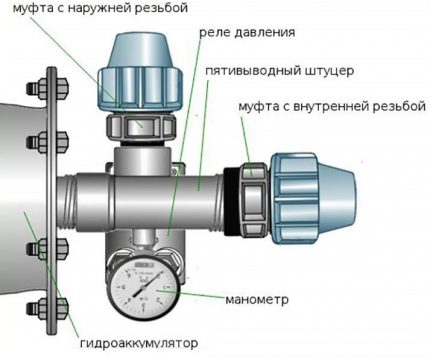
So, the accumulator is connected to the pump as follows:
- one inch output connects the fitting itself to the tank nozzle;
- quarter-inch leads connect a pressure gauge and pressure switch;
- there were two free inch leads to which the pipe from the pump is mounted, as well as the wiring going to the water consumers.
If the surface pump works in the circuit, then it is better to connect the accumulator to it with the help of a flexible hose having a metal winding.
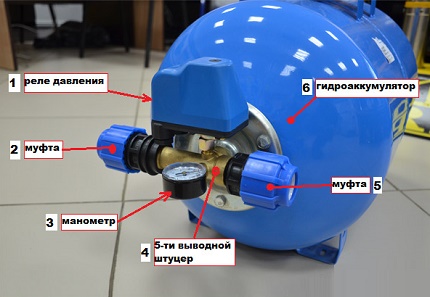
The accumulator is connected in the same way to the submersible pump. A feature of this scheme is the location of the check valve, which has nothing to do with the issues that we are considering today.
Conclusions and useful video on the topic
If after reading the text you still do not understand exactly how to connect the accumulator, watch this video in which all the nuances of this procedure are briefly, but very clearly displayed.
A hydraulic tank is an important component of a water supply system. With its help, a whole range of tasks is solved. And to make a competent connection of the accumulator with your own hands, as it turned out, is not at all difficult. But the benefits of its use are undeniable.
Have questions while reviewing the information provided? Have useful information or personal experience that I would like to share with us and with visitors to the site? Please leave comments in the block below the article.

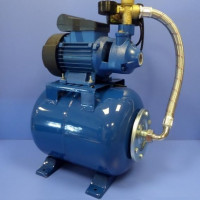 Pumping station without accumulator: operation features and water supply devices without hydraulic tank
Pumping station without accumulator: operation features and water supply devices without hydraulic tank 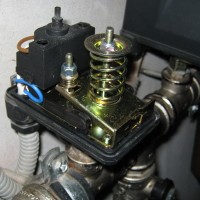 Adjusting the pressure switch for the accumulator: instructing on the equipment setup + expert advice
Adjusting the pressure switch for the accumulator: instructing on the equipment setup + expert advice  Connecting a pumping station to a well: rules for organizing autonomous water supply
Connecting a pumping station to a well: rules for organizing autonomous water supply 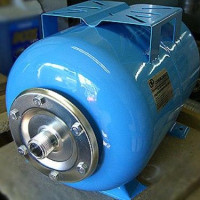 Hydraulic accumulator: device and principle of operation of a hydraulic tank in a water supply system
Hydraulic accumulator: device and principle of operation of a hydraulic tank in a water supply system 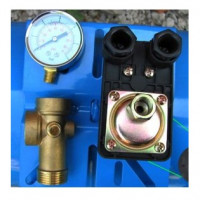 Water pressure sensor in the water supply system: specifics of use and adjustment of the device
Water pressure sensor in the water supply system: specifics of use and adjustment of the device  Principle of operation and design of a typical pumping station for water supply
Principle of operation and design of a typical pumping station for water supply  How much does it cost to connect gas to a private house: the price of organizing gas supply
How much does it cost to connect gas to a private house: the price of organizing gas supply  The best washing machines with dryer: model rating and customer tips
The best washing machines with dryer: model rating and customer tips  What is the color temperature of light and the nuances of choosing the temperature of the lamps to suit your needs
What is the color temperature of light and the nuances of choosing the temperature of the lamps to suit your needs  Replacement of a geyser in an apartment: replacement paperwork + basic norms and requirements
Replacement of a geyser in an apartment: replacement paperwork + basic norms and requirements
My house in the village is far from the water tower. Therefore, in the summer during the watering season, and in winter in severe frosts, there is practically no water in the house. The question is not even to swim, sometimes there was no water to drink.
He put an expansion tank at the water inlet to the house, on the overhangs and the valve. That is, when there is water in the pipeline, I do not use the tank, there is no water, I take it from the drive. It helped, now no matter what time of year, there is always water.
The only thing is to carefully choose a tank for your tasks, take a large one, overpay, take a small one, its volume will not be enough. Therefore, calculate your daily consumption, add 50 liters to it, and take such a tank.
Six years ago, a hydraulic tank and a pressure switch were installed in the country to automatically turn on the pump. The hydraulic accumulator was taken at 24 liters. But the pump anyway in the first year failed, we thought that we got defective. Since the pump could not be repaired, we bought a new one. But he too quickly burned out. They began to look for the reason, the pump specialist advised replacing the accumulator with a larger one. After the replacement, the system has been working smoothly for the third year.
We bought AquaLiv BNU-50 Favorite for a private house. Given the presence of a well, the Aquarius BTsP was connected with a submersible pump. The domestic pump installation has shown itself well, for the third year now there have been no problems. Just be sure to check the pressure in the air tank once a month so that it is about 2 bar.
I have some kind of problem with the outlet water pressure. When the pump is connected, 1.5 bar, when off 3.0 bar. What can be wrong? Leaky membrane?
How to place the accumulator on the wall? Should the water supply come from above or below? Or doesn't it matter?